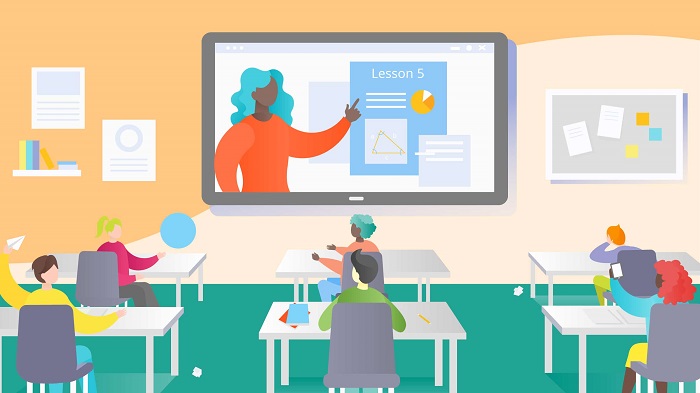Technology: An Inevitable Aspect Of Modern Classrooms

A Definitive Guide To VoIP Encryption And Security
December 28, 2021
How Teachers And Curriculum Will Shape Ed Tech’s Future?
January 3, 2022Technology: An Inevitable Aspect Of Modern Classrooms

Technology: A Mandatory Aspect Of The Learning Environment
Learning environments are more dynamic now than ever, and so are today’s learners. They are very different from the ones our educational system was designed for. Modern classrooms are being remodelled and redefined in various ways to meet the needs of modern digital learners.
As remote learning becomes more popular, higher education institutions increasingly substitute traditional resources with educational technologies. For example, many private schools in Chennai (https://www.babajividhyashram.org/) integrate many tech tools to simplify teaching and learning methods. Here’s a list of CBSE schools in Chennai adopting tech tools to impart education.
Let’s now explore the reasons for incorporating technology into the classroom and its impact on student engagement.
Why Do Modern Students Need Technology?
Students require technology in classrooms for various reasons, and classrooms have been remodelled to meet these needs. Students in higher education require technology in the classroom because of the rise of distance learning. Besides, students who want to succeed in the twenty-first-century workplace must have a basic understanding of certain technological tools. Today’s students require technology to learn, work, communicate, network and communicate with their parents.
When technology enhances students’ learning experience, they become more engaged with the learning objectives, and their individual learning needs are met. Moreover, technology allows teachers, parents and students to communicate more. Students can communicate with their peers and class teachers when the need arises.
Here’s a brief look at what technology can do for students. It can help them:
- Become more responsible individuals
- Improve their decision-making abilities
- Become more creative and innovative
- Master many technical skills
- Improve students’ productivity and engagement
- Enhance their future career opportunities
- Improve their math, spelling, and phonetics
Technology is helping students to find information more quickly and accurately, and they can receive personal tutoring through educational videos. Technological advancements also allow instructors to deliver lessons to students through interactive video games, making learning more fun and exciting in the classroom.

Benefits Of Technology Integration In The Classroom
Technology in the classroom is a boon and a must for modern students. With tech integration, students can:
- Complete their work early and participate in learning stations
- Watch videos, play educational games and explore other online learning activities
- Create digital content about the subjects they are studying
- Share ideas or opinions in blog posts, videos, and other digital media formats
- Take virtual tours of Grand Canyon National Park and the White House in their classes
Every student has a distinct learning style, and integrating technology will assist teachers in building relationships with their students. Teachers can experiment with different learning strategies and techniques to create a personalised learning environment in a classroom setting.
Students are already proficient digital citizens, but teachers can teach them how to be responsible digital citizens by incorporating technology in the classroom.
Most students are at odds with their studies when they hear “study”. They will be more engaged if technology is integrated into the curriculum. Students use mobile devices as learning tools, and teachers are advised to incorporate them into the classroom.
How To Incorporate Technology In Your Classroom
Technology is changing the way we work. Students should adapt to new situations and become comfortable with gadgets. A wide range of educational tools is available to support various learners.
- A virtual classroom can help meet the needs of individual learners. Identifying and creating new opportunities for students using virtual reality is a great way to increase engagement.
- SpellQuiz helps create a conducive learning environment for English spelling and vocabulary development, particularly for developing 9th and 10th-grade vocabulary words.
- You can use Powerpoint presentations to introduce a concept in the classroom and provide an opportunity for participation and interaction.
- Apps like Kahoot are useful for reviewing lessons. Teachers can also share their Kahoot with other teachers and students anonymously. They can decide if they want students to work independently or in groups based on their preferences.
- Mobile devices are becoming more popular for school use and are increasing productivity and communication.
- Students can use Microsoft Office and Google Drive to create spreadsheets, slide show presentations, and share documents to help them succeed in college and their future careers.
- Incorporate social media into your classroom strategy. For example, you can set up a Facebook group specifically for your class or create hashtags on Twitter.
- Using online surveys and polls to get feedback from students is essential for determining how well the classroom structure and curriculum assists students in their learning.
- Using multimedia to engage students, such as videos and slideshows, can help increase engagement and teach about technology.
- Create an online calendar for your classroom so that everyone can see when important updates are made.
The Disadvantages Of Using Technology In Classrooms
When technology is used in the classroom, students are often successful. The downsides include potential distractions, but the benefits outweigh any disadvantages when routines are in place.
Parents are sceptical about how mobile technology will affect their child’s classwork. Besides, some schools are not completely on board with implementing technology in their classrooms. Lack of infrastructural support, including a lack of Wi-Fi/wireless networks to support the technology, is also why schools are wary of tech implementation.
Technology can be compared to a two-edged sword, and teachers who help students use mobile devices can help them develop a better sense of what is right and wrong. Many people believe that integrating technology will burden school districts.
However, simple technologies can help auditory or visually impaired students become more engaged in their learning. Technology in the classroom will allow students to access up-to-date information more expeditiously and conveniently, adapting to the changing environment. Read More

